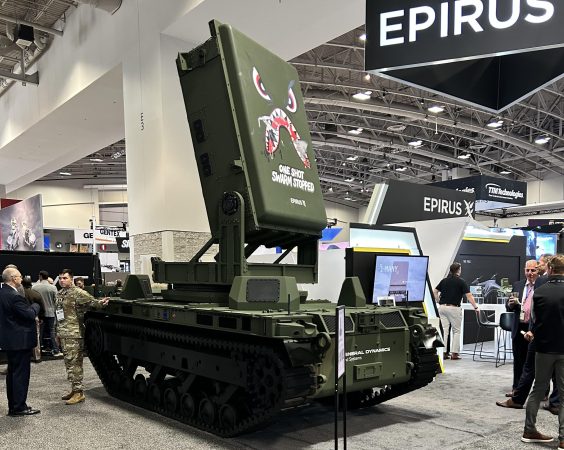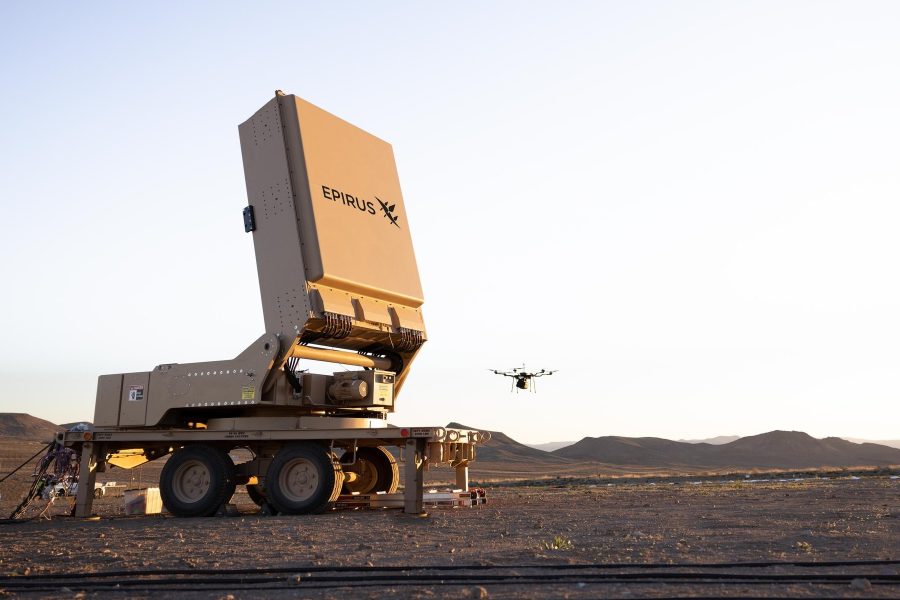This year’s Association of the United States Army’s annual meeting buzzed with talk of countering the rapidly evolving drone threat facing the entire U.S. military, including the Air Force. Leaders and defense industry officials discussed the need for new approaches to procurement and employment of a new class of these weapons.
Air Force counter-drone officials may test Epirus Inc.’s high-power microwave system that boasts a track record of killing dozens of drones with one shot, the firm’s CEO said Oct. 14 at the AUSA conference.
On the exhibit floor, Epirus unveiled the latest version of its Leonidas high-power microwave system mounted on a General Dynamics robotic tracked vehicle. During a live-fire demonstration in late August, a version of Leonidas downed a swarm of 49 drones with a single pulse.

Epirus CEO Andy Lowery described the weapon as a counter-electronics system that temporarily disrupts and disables all sizes of drones.
“It creates voltage-inducing conditions around the circuit board, so if you can imagine this field of electromagnetic energy in the atmosphere, and the boards and wires themselves pull in that electromagnetic energy which creates a voltage noise on the circuit boards,” Lowery told Air & Space Forces Magazine.
The result is similar to the “blue screen of death” that Microsoft Windows users often suffered during a system error that could only be fixed by rebooting the computer, Lowery said.
The Leonidas has the same effect on drones. “We knock down a drone, and if it doesn’t break from the fall, you can go grab it, turn off the power, turn the power back on again … and then the system will start,” Lowery said, adding that it can then be examined for forensic information.
The Air Force Research Laboratory has been experimenting with counter-drone systems such as the Tactical High-power Operational Responder, or THOR, since 2019. In a follow-on effort, the lab selected Leidos in 2022 to begin development a similar system dubbed “Mjolnir” after the hammer wielded by the Norse god Thor.
The services counter-drone officials began to express interest in the Epirus system after the firm sold its first Leonidas systems to the Army in 2023.
“We’ve been working with the Air Force for about two years in earnest,” Lowery said. “They have a lot of high, high-value targets, like F-35. They’ve got nuclear missiles. They’ve got this, they’ve got that, and they’ve got a big drone problem.”
But the Air Force is more interested in testing the trailer version of the Leonidas, and not the robotic tracked vehicle it teamed with General Dynamics to bring to AUSA, he said.
“This is a military standard trailer that they can tow with any sort of pickup truck or anything like that,” Lowery said. “We think in 2026, they may lease two to four systems; that is what they’ve been looking at.”
But that doesn’t mean the Air Force has given up on Mjolnir, a redesigned version of Thor to meet the Air Force’s need for counter-drone systems that can be rapidly deployed under the service’s agile combat employment, or ACE, strategy. It involves small teams of Airmen setting up temporary airbases in forward, undefended locations on the battlefield.
The Air Force Research Laboratory recently extended its contract with Leidos to complete an “ACE-compliant” prototype that the Air Force could test next summer, according to a Leidos official, who was not authorized to speak to the press.
The Air Force did not respond to a request for comment on this story by press time.
Also this week, AeroVironment Inc. announced it would send long-range counter-drone sensor technology Grand Forks Air Force Base, N.D. as part of an effort to support President Donald Trump’s Golden Dome homeland defense shield effort. The defense firm is partnering with GrandSky, a commercial drone business and large aviation park located next to the air base, according to AeroVironment’s website.
AeroVironment will send its Titan and Titan-SV systems for detecting and identifying drones at great distances around the base. The firm’s AV Halo Command software platform will then fuse the data into a common operating picture. The effort is a result of a March memorandum of understanding between AeroVironment and GrandSky that supports Project Ultra, a $110 million initiative—led by Sen. John Hoeven (R-N.D.)—to make Grand Forks a proving ground for counter-drone defense technology.
Meanwhile miliary leaders and other defense industry officials say that it will take more than just the latest counter-drone weapon to solve the Pentagon’s enemy drone problem.
Every counter-drone weapon has to be inexpensive and expendable, Retired Army Lt. Gen. Neil Thurgood, senior vice president for Anduril, said Oct. 14 during a discussion hosted by the Pentagon’s new counter-drone office, known as the Joint Interagency Task Force 401.
“We’ve got to realize that it’s going to be temporary,” Thurgood said. “We’ve got to realize that it’s going … to be exercised, it’s going to be used to kill something or get killed. And we’re going to move on to the next thing.”
Army Brig. Gen. Matt Ross, director of JIATF 401, agreed with Thurgood, adding that future counter-drone weapons will have to be treated like other munitions.
“Your counter-UAS load is just that—it’s a basic load, and it will be expended,” Ross said. “They’re expendable, and we should be procuring them at a price point that ensures they’re expendable, and we should train with them as if they’re expendable, or we’ll never have the proficiency we need to use them effectively.”


